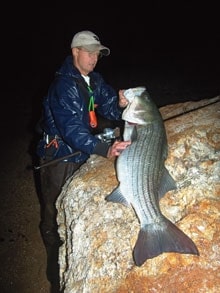
|| |—| || |ROCK FISH: Big stripers have a hard time resisting a modified metal-lipped swimmer. Photo: Laptewproductions.com| I started tinkering with metal-lipped swimming plugs to improve my odds in the surf in the early ’60s. I was schooled by a group of hardcore anglers from the Westport Tackle Shop in Connecticut. One trick they taught me was to modify a swimming plug, such as a Junior Atom or Gibbs, to splash so it swam like a crippled baitfish. In and around structure, in rolling surf, along dropoffs and even in calm water, a swimming plug that pops or splashes will attract big fish to the surface.
There is no fast, easy way to make a metal-lipped swimming plug splash and still swim properly. This is true with production models like Atoms and Gibbs and even the special handmade plugs from smaller companies. Most of the plugs will work fairly well, but only one out of ten will splash and swim properly without tweaks.
Balancing Act

| |TWEAK ME: A metal-lipped swimming plug hard time resisting a modified metal-lipped swimmer. Photo: John Merwin| To tune a plug, begin by bending its metal eye down slightly. Test it by making a short cast, then start your retrieve and give a soft tug on the rod. The plug should pop on the surface, throw some water and keep swimming. If you don’t get the desired results, keep bending the eye down until the plug splashes easily and swims on or just below the surface. Some plugs require bending both the lip and eye down to make them splash. Bend carefully, keeping the lip straight. If you torque the lip to one side, or bend the lip too much, it effects the action of the plug. You can even bend and cup the edges of the lip with pliers, but this must be done with care, or you could ruin the plug.
Tweaking is a balancing act: The plug should splash with a short pull of the rod tip and still maintain a good, sharp kicking action in its tail. If the plug swims with a rolling, sluggish action, it is not as effective. A perfectly working plug is one that pops easily at the end of the cast and swims slightly tail-high with a sharp, darting action. It’s fine if the plug swims just below the surface, as long as it pops easily. I have some Junior Atoms that work just under the surface and splash effortlessly-they are deadly.
Changing hooks can also make a difference. I always change the tail hook to a single Siwash and dress it with bucktail. Some plugs come with a tail dressing without a tail hook, which often lets them move better in the water. A dressed tail adds length and gives the plug additional action and movement. Also try increasing the front treble hook by one size. The bigger hook has better holding power and will give the plug a slightly nose-down swimming action.
Splash Down
The key to working these plugs is to splash them right after they hit the water and then to keep splashing them every ten to 15 feet during the retrieve. A good trick is to keep moving the rod from side to side to change the direction of the plug. Lower the rod off to one side parallel to the water, then pop the plug and swing the rod to the opposite side while continuing to reel. When the plug is a long distance away there will be less change in direction, but once it gets closer the plug will lurch from side to side like a big crippled baitfish.
When fishing a rip, cast at different angles to the current using the rod tip to control the plug. If there is enough current, quarter your casts down the flow without reeling, letting the water movement carry the plug and pop it every few feet. Work structure or dropoffs in the flow by casting above the holding areas and splashing the plug hard just before it reaches prime water. In calm water at low light use a slow retrieve and pop the plug softly. During the day, a fast retrieve with hard pops can be effective. When fishing a beach with rolling surf, cast the plug at an angle to the shoreline and keep swimming and splashing the plug so it walks along, just outside the break. Fish the flow along a beach like a rip or try casting and working the plug while walking along the shoreline at the same pace as the flow.
Right off the shelf, metal-lipped swimming plugs will catch fish. But with some adjustments these lures can become real killers.









